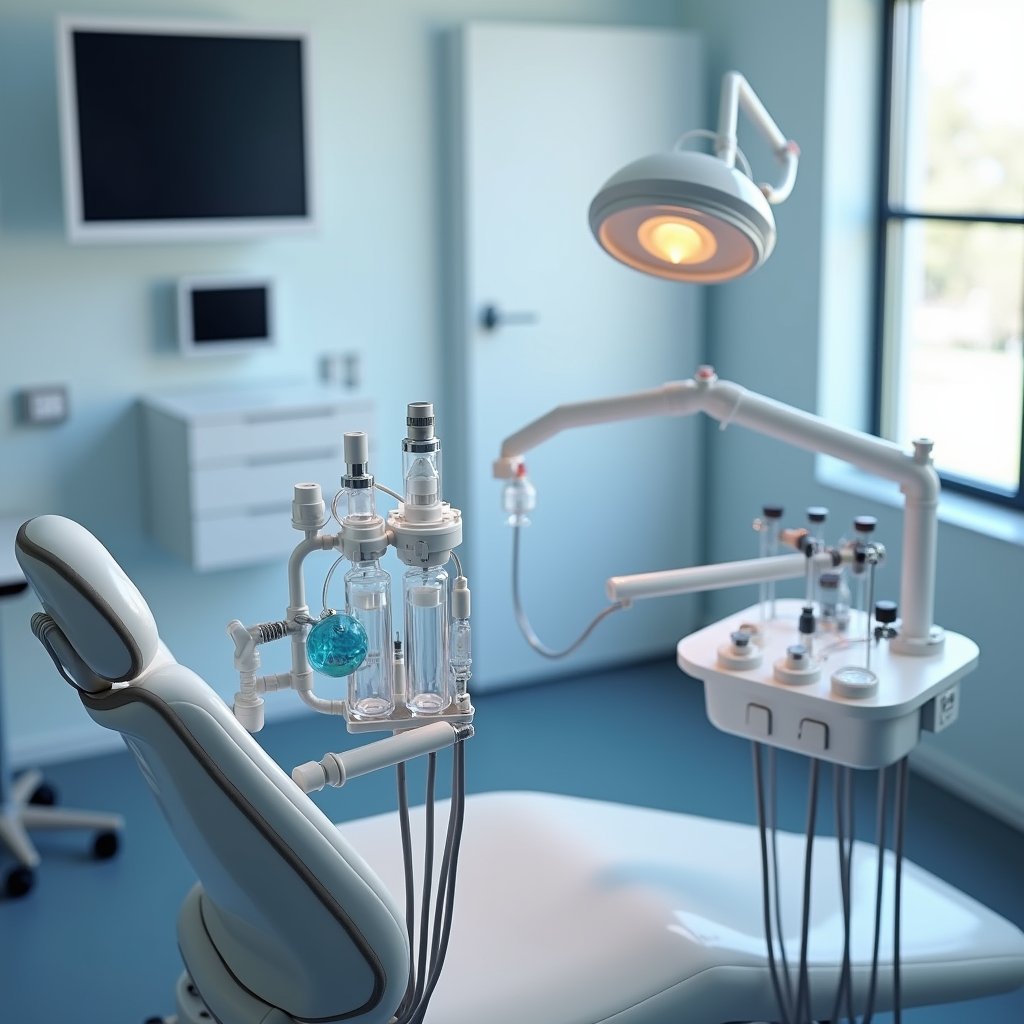Dentists use nitrous oxide to help you feel calm and comfortable during dental procedures. You’ll experience rapid-acting sedation within 2-3 minutes, reducing both anxiety and pain while staying conscious throughout treatment. The gas enhances local anesthetic effectiveness and produces a mild euphoric sensation that suppresses your gag reflex. It’s safe for all ages, with a quick recovery time that lets you resume normal activities immediately. Understanding its complete benefits can transform your dental experience.
Understanding the Role of Nitrous Oxide in Dental Care

While dental procedures can trigger anxiety and discomfort in many patients, nitrous oxide serves as a valuable tool in modern dentistry by providing both analgesic and anxiolytic effects. You’ll experience mild pain relief through endorphin stimulation and increased pain threshold levels, enhancing the effectiveness of local anesthetics without requiring injections. The gas is always administered as a mixture with oxygen through a comfortable nose mask. Nitrous oxide is especially beneficial since it has the fastest onset time compared to other inhalation anesthetics. The sedation method is safe for all ages, making it a versatile option for both children and adults.
Under strict operator oversight and regulatory guidelines, nitrous oxide delivers rapid relief within minutes. It’s particularly effective for various procedures, from routine cleanings to more complex extractions. You’ll maintain consciousness while experiencing reduced anxiety and discomfort. The treatment is cost-effective compared to IV sedation and allows for real-time dose adjustments based on your needs.
After administration ends, you’ll recover quickly and can resume normal activities, making it a practical choice for both brief and extended dental procedures.
Anxiety Management and Patient Comfort Benefits
Nitrous oxide’s profound impact on anxiety management stands as one of its most valuable benefits in dental care. You’ll experience significant improvements in your psychological mindset during procedures, as it effectively reduces dental phobia and enhances your overall mood. The sedation effects begin working within 5-6 minutes of inhalation, altering your physical sensations to make the treatment more comfortable. Compared to oral midazolam, nitrous oxide has far fewer complications during dental procedures.
Clinical data shows that 90% of pediatric patients can complete their procedures with fewer interruptions when using nitrous oxide. Studies demonstrate that patients receiving nitrous oxide show significantly lower heart rates compared to those using conventional behavior guidance techniques. It’s particularly effective for school-aged children and serves as an excellent alternative to hypnosis for anxiety control. With a 93.6% success rate in sedation and analgesia during tooth extractions, you’ll find that nitrous oxide consistently delivers reliable anxiety reduction while maintaining your normal protective reflexes throughout the procedure.
Safe and Effective Pain Control Methods

The safe and effective pain control properties of nitrous oxide stem from its sophisticated interaction with multiple neural pathways. When combined with proper numbing techniques, you’ll experience rapid pain relief while maintaining consciousness during procedures. The gas enhances local anesthetic effectiveness while requiring lower doses for ideal results. Since the mid-19th century, physicians and dentists have relied on nitrous oxide as a trusted sedation method. For maximum comfort during treatment, the gas is administered through a breathing mask that delivers a precise mixture of nitrous oxide and oxygen. The calming effects help patients by producing a euphoric sensation that reduces dental anxiety.
| Pain Control Aspect | Benefit | Clinical Impact |
|---|---|---|
| Onset Speed | 2-3 minutes | Immediate relief |
| Duration Control | Adjustable flow | Seamless treatment experiences |
| Recovery Time | Under 5 minutes | Quick return to normal |
You’ll benefit from nitrous oxide’s ability to target both physical and psychological pain components through neurotransmitter modulation. Its ADA-endorsed safety profile means you can receive effective pain management with minimal side effects, while the precise dose control guarantees consistent comfort throughout your dental procedure.
Key Advantages for Different Patient Groups
Dental professionals strategically employ nitrous oxide sedation to address the unique needs of diverse patient populations. Through sedation effects optimization, they can tailor the approach for children, reducing anxiety while ensuring positive early dental experiences. The colorless, odorless gas ensures maximum comfort with minimal sensory disruption.
For adults with dental fears, customized administration approaches allow them to remain conscious yet comfortable throughout procedures. The gas produces conscious sedation while maintaining patient awareness and cooperation.
For patients with strong gag reflexes, nitrous oxide helps suppress this reflex during essential treatments and imaging. Elderly patients receive precisely regulated sedation that’s compatible with their medications, while maintaining ideal oxygen levels.
For those with busy schedules, the rapid onset and quick recovery make it a perfect choice, allowing you to return to normal activities shortly after treatment. This versatility makes nitrous oxide an invaluable tool in modern dentistry.
Practical Applications During Dental Procedures

Building on the adaptability of nitrous oxide for different patient groups, its practical applications span numerous dental procedures with precision-based implementation. You’ll find enhanced diagnostic accuracy and streamlined restorative procedures through controlled sedation, allowing your dentist to work efficiently while maintaining your comfort. The combined with oxygen mixture provides a safe and effective way to deliver sedation through a specialized mask. The rapid onset of the sedative effect helps patients relax quickly during procedures.
Complex treatments like root canals and crown placements become more manageable with adjustable sedation levels. Gag reflex suppression enables better imaging and impression-taking procedures. Anxiety management improves cooperation during intricate periodontal treatments. Extended procedures can be completed in fewer sessions due to sustained comfort. Pain control during invasive interventions guarantees ideal treatment outcomes.
This targeted approach to sedation transforms challenging dental procedures into controlled, efficient treatments while maintaining safety protocols and guaranteeing your quick recovery afterward.
Frequently Asked Questions
Can I Drive Myself Home After Receiving Nitrous Oxide Treatment?
While you may feel alert shortly after nitrous oxide treatment, you shouldn’t drive yourself home immediately. Potential side effects like drowsiness and impaired judgment can persist for 15-30 minutes after treatment, even with careful monitoring during the procedure. You’ll need to wait at least 15-30 minutes post-treatment and receive clearance from your dentist.
For safety, it’s best to arrange alternative transportation or have someone drive you home.
How Long Before My Appointment Should I Stop Eating?
You’ll need to follow specific fasting guidelines before your nitrous oxide treatment. Generally, stop eating solid foods 4-6 hours before your appointment to minimize any risks during sedation.
You can have light, easily digestible foods up to 2 hours before, and clear liquids until about 1 hour prior. However, these dietary restrictions may vary by clinic, so it’s crucial to confirm specific fasting duration requirements with your dental team beforehand.
Will I Remember Anything That Happens During the Procedure?
You’ll likely have a fragmented memory of your procedure. While under nitrous oxide, you’ll maintain a conscious state and basic sensory perceptions, but your ability to form clear memories will be temporarily reduced.
You may remember some parts of the procedure while other details become hazy. This memory-reducing effect is dose-dependent and reversible. Once the gas is stopped and you receive oxygen, your memory formation will return to normal.
Does Insurance Typically Cover the Cost of Nitrous Oxide Sedation?
No, you typically won’t receive insurance coverage for nitrous oxide sedation. Most dental insurance plans classify it as an elective procedure with specific coverage limitations. You’ll usually need to pay for this service out-of-pocket.
While some rare exceptions exist for medical necessity or complex procedures, cost considerations generally fall on you as the patient. It’s best to verify with your specific insurance provider and discuss payment options with your dental office beforehand.
Can I Request Nitrous Oxide for Routine Cleanings and Check-Ups?
Yes, you can request nitrous oxide for routine cleanings and check-ups. If you experience dental anxiety or sensitivity, this form of pain management can substantially enhance your comfort during these procedures.
You’ll need to discuss this option with your dentist, who’ll evaluate your medical history and determine if it’s appropriate for your situation. While it’s not always necessary for routine visits, it’s available if you need additional relaxation support.






